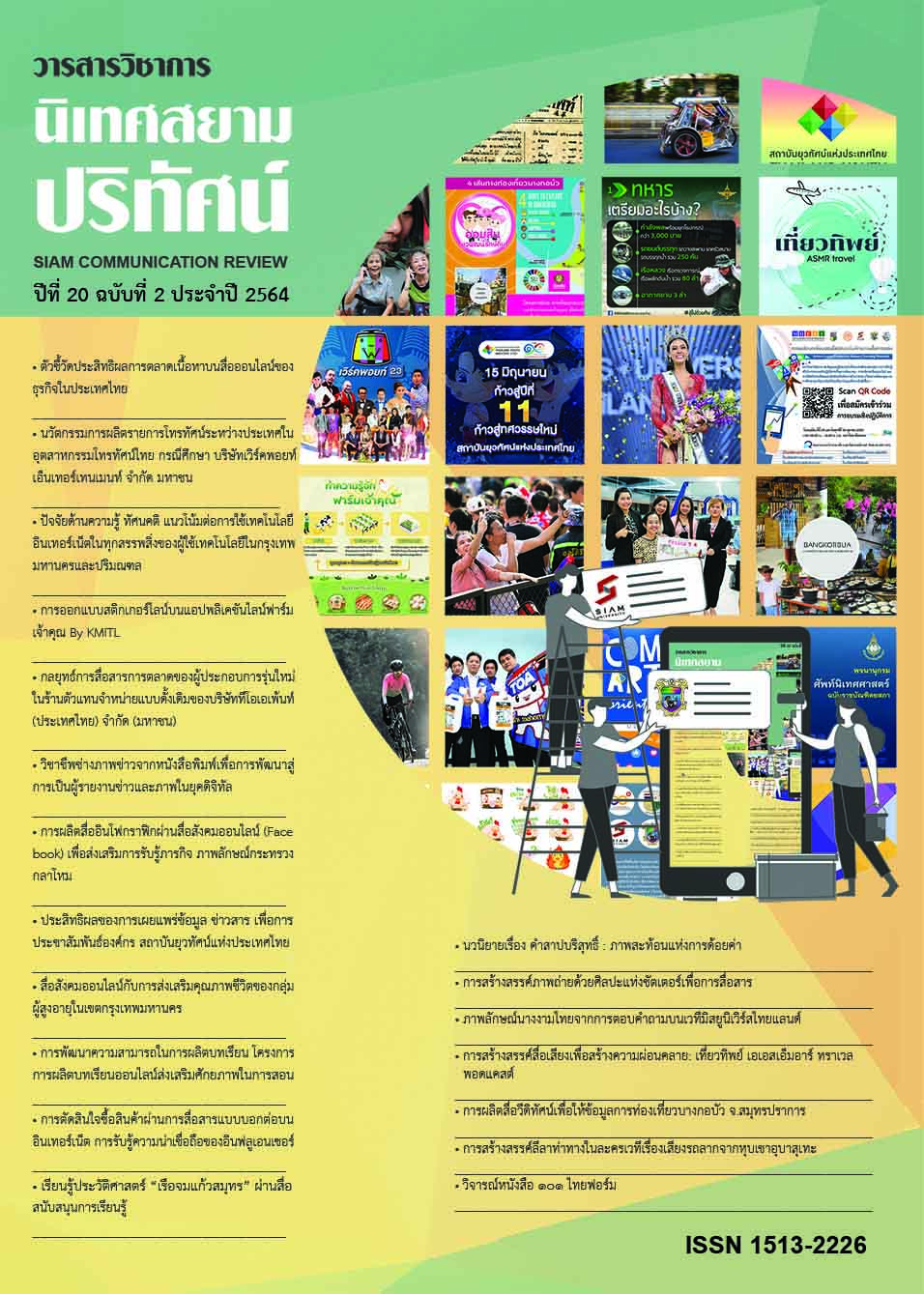Co-Production TV Production Innovation in Thai Television Industry:The Case Study of Workpoint Entertainment Public Company Limited
Main Article Content
Abstract
The aim of this article is to study of knowledge that occurs in the Thai television industry that has developed a production model. And creating TV content Until it became an innovation in international television production. Its objective is to study the origin of innovation in international television production, the structure and concept of international television production innovation and how innovation in international television production affects the industry Thai Television. By means of data collection by studying related documents from the government sector and related agencies In-depth interviews with key informants of Thai manufacturers This includes collecting data with a foreign main informant who is a Korean manufacturer and idol groups that have worked with producers in Korea Specific will be jointly between Thailand and Korea The mask singer, I can see your voice, Beauty No.9
In this research study, it was found that the definition of international television program innovation co-production is an international collaboration in producing innovative television programs. Which must occur between TV producers from 2 countries or more by utilizing cooperation in many areas, it must be innovative. And the extension can actually be used and business benefits and business benefits However, in the production of such innovations, it can also be seen that the process of producing television content in general findings from innovation are the story of (2 D) Development, the development stage of distribution, and (1 E) evaluation, including Workpoint's international collaborative television production model, which is important in building a production guideline. That will benefit the Thai television industry in the future.
Article Details
References
ธนกฤต สังข์เฉย. (2555). ความแตกต่างทางมิติวัฒนธรรมกับพฤติกรรมนักท่องเที่ยว. วารสารมนุษยศาสตร์และสังคมศาสตร์มหาวิทยาลัยมหาสารคาม, 31(5), 61-72.
บุญธรรม กิจปรีดาบริสุทธิ์. (2540). ระเบียบวิธีการวิจัยทางสังคมศาสตร์ (พิมพ์ครั้งที่ 7). นนทบุรี: โรงพิมพ์และทำปกเจริญผล.
ปาริชาติ สถาปิตานนท์. (2549). การสื่อสารแบบมีส่วนร่วมและการพัฒนาชุมชน: จากแนวคิดสู่ปฏิบัติการวิจัยในสังคมไทย กรุงเทพฯ: สำนักงานกองทุนสนับสนุนการวิจัย (สกว.).
พัชราภา เอื้ออมรวนิช. (2558). การศึกษาปัญหาการสื่อสารระหว่างวัฒนธรรมและแนวทางการปรับตัวของอาจารย์ต่างชาติกับนักศึกษาไทยในมหาวิทยาลัยราชภัฏในเขตกรุงเทพมหานคร. กรุงเทพฯ: มหาวิทยาลัยราชภัฏธนบุรี.
มานพ คณะโต. (2550). วิธีวิทยาการวิจัยเชิงคุณภาพในระบบสุขภาพชุมชน. ขอนแก่น: เครือข่ายพัฒนาวิชาการและข้อมูลสารเสพติด ภาคตะวันออกเฉียงเหนือ มหาวิทยาลัยขอนแก่น.
ศมกมล ลิมปิชัย. (2536). กว่าจะเป็นธุรกิจเทปเพลง กรุงเทพฯ: โครงการหนังสือชุดนิเทศศาสตร์บัณฑิตศึกษา คณะนิเทศศาสตร์ จุฬาลงกรณ์มหาวิทยาลัย.
อุบลรัตน์ ศิริยุวศักดิ์. (2545). ระบบวิทยุและโทรทัศน์ไทย: โครงสร้างทางเศรษฐกิจการเมืองและผลกระทบต่อสิทธิเสรีกรุงเทพฯ: จุฬาลงกรณ์มหาวิทยาลัย.
เอกสิทธิ์ เข้มงวด. (2557). การศึกษาเปรียบเทียบมิติทางวัฒนธรรมระหว่างไทย-ญี่ปุ่นกรณีศึกษาบริษัทญี่ปุ่นในประเทศไทย (รายงานการวิจัย). กรุงเทพฯ: คณะบริหารธุรกิจ สถาบันเทคโนโลยีไทย-ญี่ปุ่น.
ภาษาอังกฤษ
Abercrombie, N. (1996). Television and Society. Cambridge: Polity.
Berg, V. et al. (1998). Critical Approaches to Television. Boston: Houghton Mifflin.
Bignell, J. (2004). An Introduction to Television Studies. London: Routledge.
Black, J. et al. (1998). Introduction to Media Communication. Boston: McGraw-Hill.
Burton, G. (2000). Talking Television: An Introduction to the Study of Television. London: Arnold.
Butler, J. (1994). Television: Critical Methods and Applications. Belmont: Wadsworth.
Casey, B. et al. (2002). Television Studies: The Key Concepts. London: Routledge.
Corner, J. (1995). Television Form and Public Address. London: Edward Arnold.
Creeber, G. (2001). The Television Genre Book. London: BFI.
Creeber, G. (Ed.) (2006). Tele-visions: an Introduction to Studying Television. London: BFI.
Ellis, J. (1982). Visible Fictions: Cinema: Television: Video. London: Routledge and Kegan Paul.
Gomery, D., & Hockley, L. (2006). Television Industries. London: BFI.
Hall, S. (1980). 'Encoding/decoding', in Stuart Hall et al (Eds.), Culture, Media, Language. London: Unwin Hyman.
Hartley, J. (1992). Tele-ology: Studies in Television. London: Routledge.
Hofstede, G. (1990). Cultures Consequences: International Differences in Work-Related Values. California: Sage.
Holland, P. (1997). The Television Handbook. London: Routledge.
Kunczik, M. (1991). Communication and Social Change: A Summary of Theories, Policies and Experiences for Media Practitioners in the Third World. Bonn: Friedrich-Ebert-Stiftung.
Lull, J., & Sun, S. (1988). Agent of Modernization: Television and Urban Chinese Families', in James Lull (Ed.), World Families Watch Television. Newbury Park: Sage.
Lury, K. (2005). Interpreting Television. London: Hodder Arnold.
McLuhan, M. (1964). Understanding Media: The Extensions of Man. London: Routledge.
McQuail, D. (2005). McQuail's Mass Communication Theory. London: Sage.
McQueen, D. (1998). Television: A Media Student's Guide. London: Arnold.
Morley, D. (1986). Family Television: Cultural Power and Domestic Leisure. London: Routledge.
. (1991). Where the Global Meets the Local: Notes from the Sitting Room. Screen, 32(1), 1-15.
ระบบออนไลน์
กิติพัฒน์ นนทปัทมะดุลย์. (2554). เครื่องมือในการเก็บข้อมูลวิจัยเชิงคุณภาพและการสนทนากลุ่ม (Focus Group Study). เข้าถึงได้จาก http://www.priv.nrct.go.th


